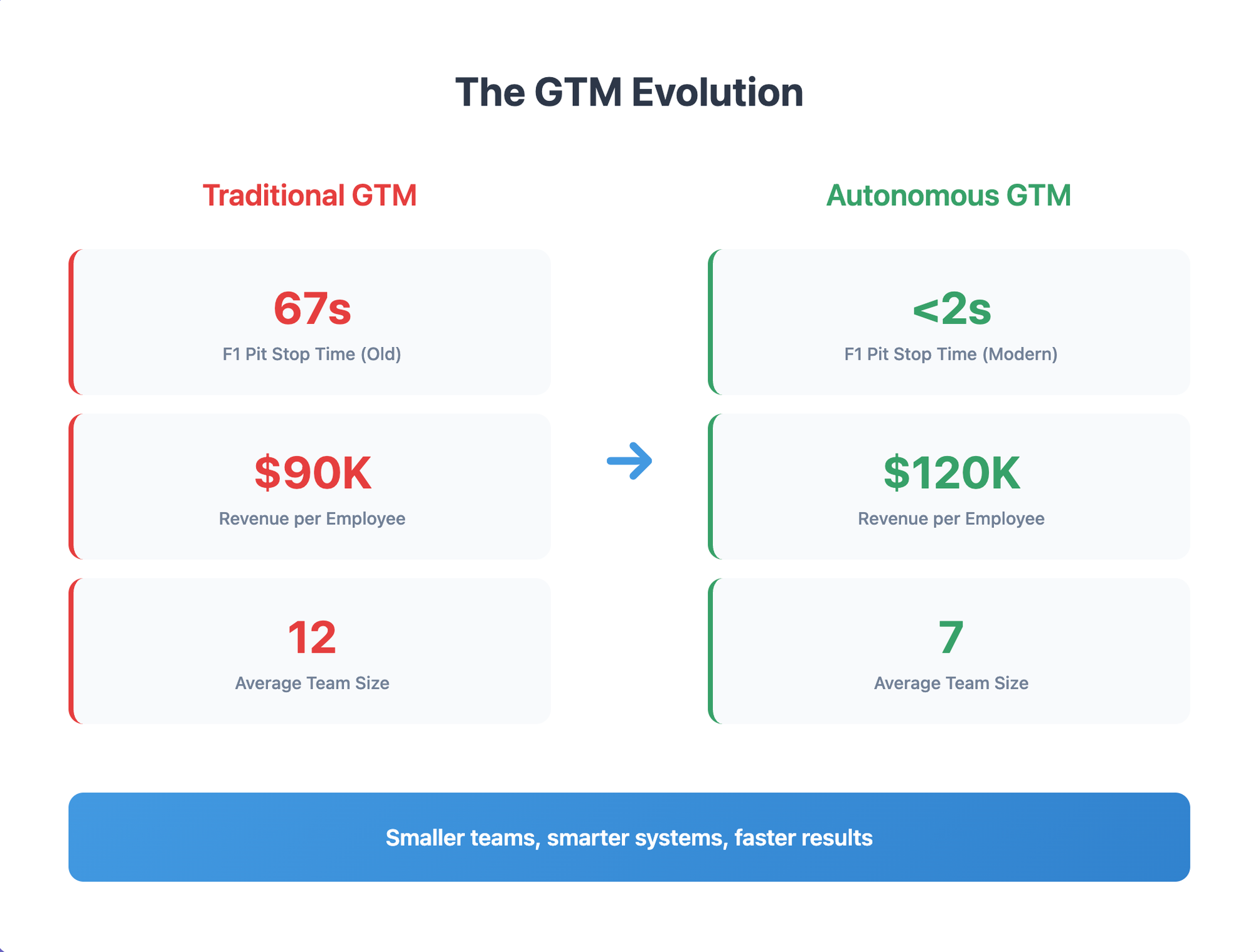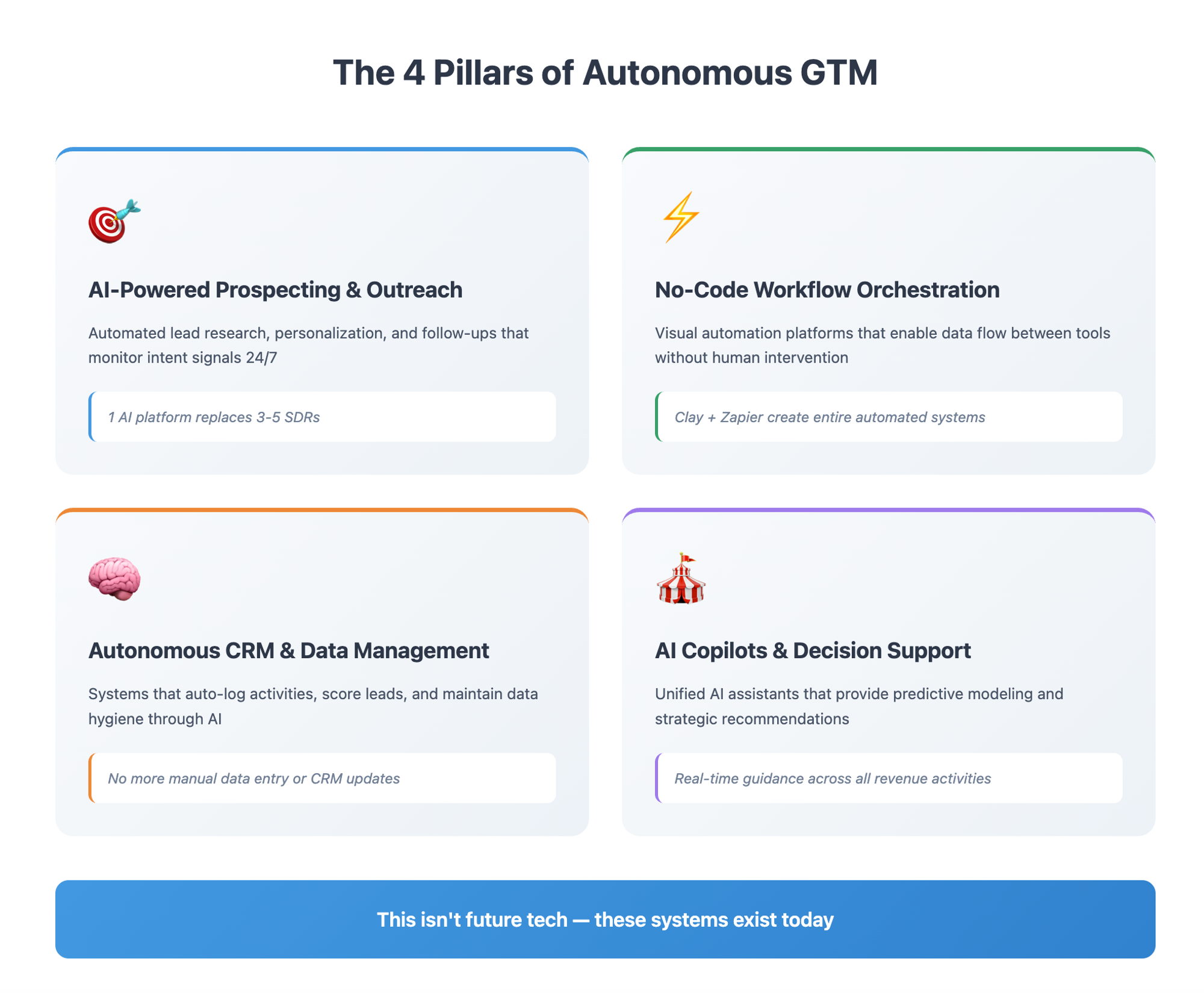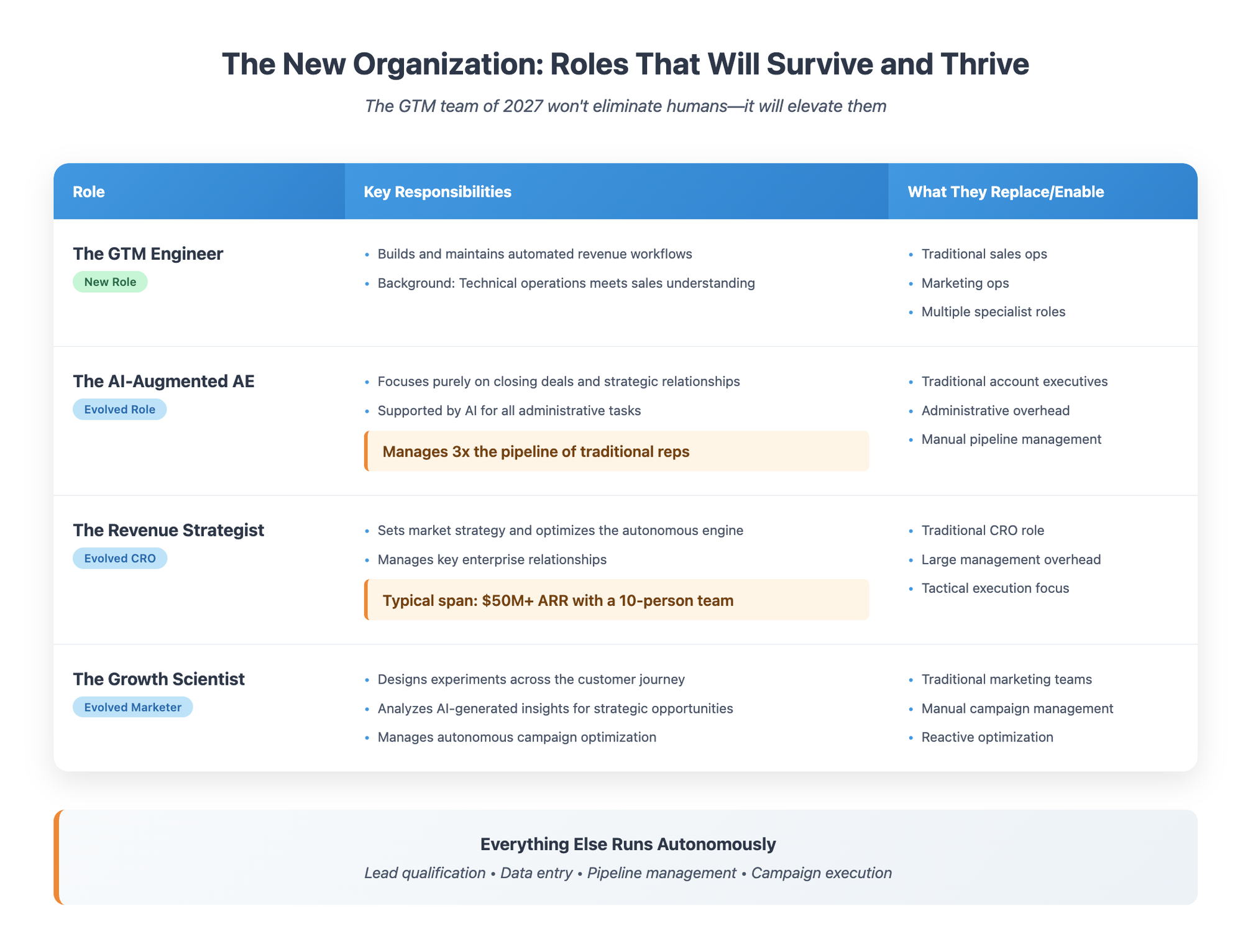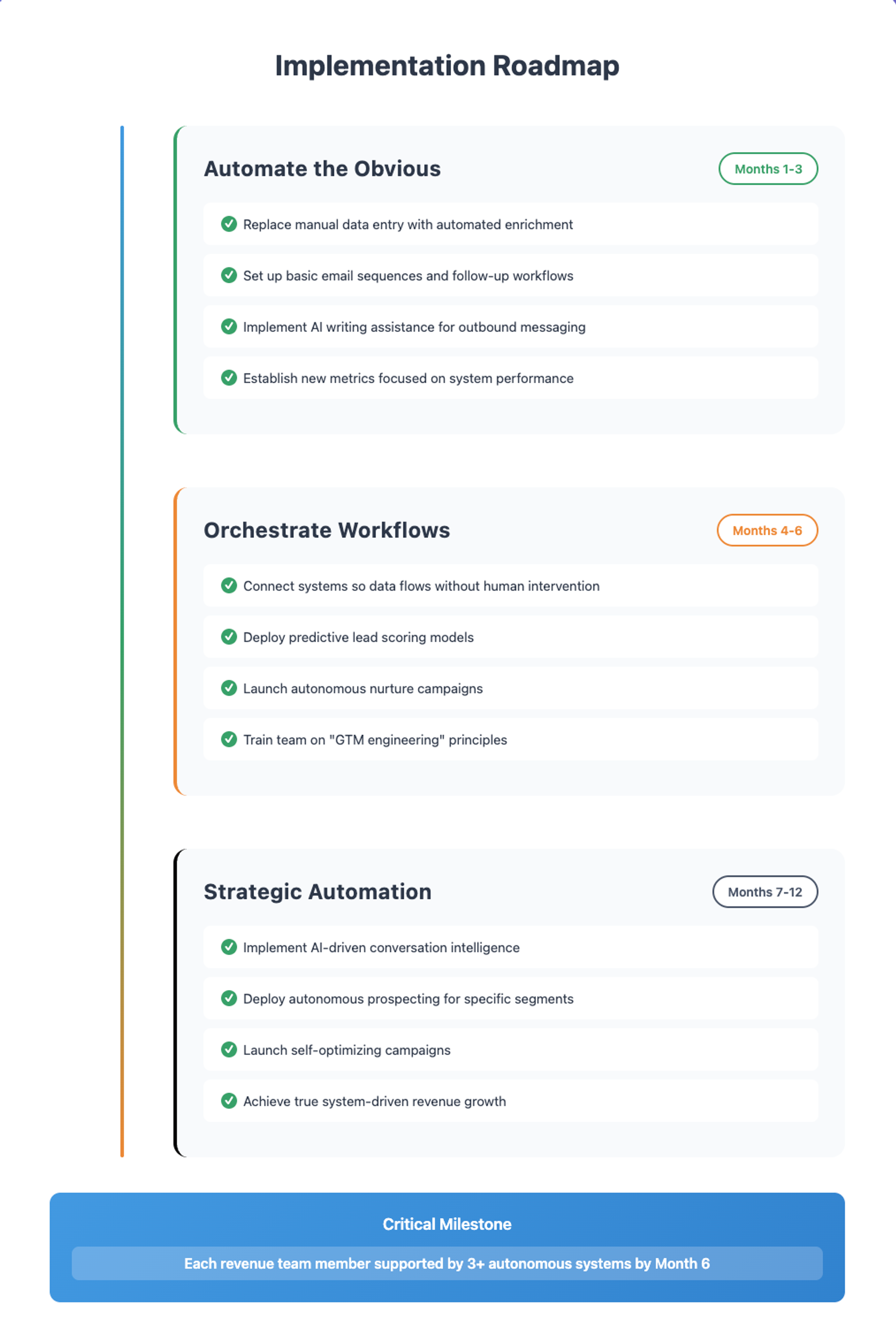Autonomous GTM: The future of revenue

For decades, building a go-to-market team was like assembling a Formula 1 pit crew.
Your AEs were your tire changers, making the critical adjustments that kept deals moving forward. Highly specialized. Incredibly skilled. Absolutely essential.
Your marketers were your fuelers, ensuring a constant flow of leads to keep the car running. Without them, even the best AEs would eventually stall out.
Your RevOps team was your race engineers, analyzing data, fine-tuning systems, and making sure everything was optimized for peak performance. Without them, you'd be racing blind.
And the Chief Revenue Officer? The crew chief, headset on, frantically coordinating it all, trying to shave milliseconds off every process while praying nothing went catastrophically wrong.
When performance lagged, what was the answer? Hire more tire specialists. Add fuel handlers. Expand the engineering team. Find a better crew chief.
This is how we've built GTM teams for as long as we can remember: add people, add complexity, add cost, and pray for speed.
But look at modern F1. The pit stops that once took 67 seconds with dozens of crew members now take less than 2 seconds with under 20 people. Advanced technology, automation, and systems thinking transformed how the fastest teams operate.
What if your go-to-market motion could undergo the same revolution? What if you could generate more pipeline, close more deals, and scale revenue with a fraction of the headcount you thought you needed?
This isn't a thought experiment. It's already happening.
The rise of Autonomous GTM
A new model is emerging that fundamentally challenges how we think about scaling revenue. We call it Autonomous GTM — a go-to-market approach where lean teams use automation and AI to execute what used to require entire pit crews of specialists.
This isn't about adding another tool to your tech stack. It's about fundamentally reimagining your operating system.
Think less "let's hire more people" and more "let's build a smarter machine."
Look around and you'll see early signs everywhere:
- Loom reached $7.5 million in ARR with just 5 team members total
- Bolt and Lovable went from $0 to $15M ARR in two months with only 15 employees
- Anthropic handled an explosive influx of inbound leads with a tiny GTM team by implementing AI-driven workflows
These aren't outliers — they're early adopters of a shift that's about to transform how we all grow revenue.
The old playbook is breaking down
For decades, scaling revenue meant scaling headcount. The math was simple:
- Need more meetings? Hire more SDRs.
- Need more content? Build a bigger marketing team.
- Need better systems? Expand RevOps.
It made for impressive slides in board meetings. It felt like building something substantial. But just like those massive old pit crews, this approach has been breaking down under its own weight:
- Teams became siloed, creating handoff friction
- Data got trapped in tool sprawl
- Each new hire added administrative overhead
- Visibility into the customer journey fractured
- CAC ballooned while productivity plateaued
Meanwhile, the world changed. The free money era ended. Efficiency became the new growth. And technology made a quantum leap forward.
Why now? The perfect storm
Three forces have converged to make this moment possible:
- AI that works: Generative AI and machine learning have matured beyond toys into true productivity amplifiers. What used to be science fiction (AI that can write effective emails, analyze calls, and predict customer behavior) is now commodity tech.
- No-code democratization: Tools like Clay, Zapier, and Bardeen have put automation in the hands of non-engineers. The GTM team no longer needs to file tickets and wait for engineering time.
- Economic reality: After the 2020-2022 boom, hiring sprees gave way to tighter budgets and smarter scaling. Companies need to do more with less.
OpenView's 2024 benchmarks tell the story: early-stage SaaS teams (<$5M ARR) shrank from an average of 12 people to just 7 year-over-year, while revenue per employee jumped from $90K to $120K. And the top-quartile growth rates? They increased to 250%, up from 150%.
In other words: smaller teams are growing faster than ever before.

From manual pit stop to autonomous racing: how CRMs evolve
Autonomous GTM requires a different foundation. Most CRMs are still glorified databases that expect humans to do all the work: input data, create tasks, log emails, build reports. Even the ones claiming "AI" just wrap old workflows in new buzzwords.
Clarify flips that on its head. It's not a tool you use—it's a system that works for you.
As the world's first truly autonomous CRM, Clarify listens, learns, and acts without being told. You focus on strategy and closing. It handles the rest.
Think of it like the difference between a standard car and a self-driving vehicle. In a standard car, you handle every aspect of driving—steering, acceleration, navigation, hazard detection. In a self-driving car, the system takes on most of these tasks, requiring only occasional human intervention.
Traditional CRMs are manual vehicles where salespeople do all the work. Clarify is a self-driving revenue machine that turns your GTM team into strategic operators rather than data janitors.
The new racing engine

So what exactly makes up an autonomous GTM system? It's not a single tool, but an integrated performance engine:
1. AI-Powered Prospecting & Outreach
- Tools like Common Room, Pocus, or UnifyGTM act as AI SDRs, automating lead research, personalization, and follow-ups
- They monitor intent signals 24/7, crafting personalized outreach at the perfect moment
- One AI platform can effectively replace what used to be a team of 3-5 SDRs
2. No-Code Workflow Orchestration
- Platforms like Clay and Zapier enable "GTM engineers" to build entire automated systems visually
- Data flows automatically between tools, triggering actions without human intervention
- The sales motion happens in the background while humans focus on relationships
3. Autonomous CRM & Data Management
- Systems that auto-log activities, score leads, and even draft follow-up tasks
- Data enrichment that pulls in firmographic and contact information automatically
- CRM hygiene maintained through AI, not human data entry
4. AI Copilots & Decision Support
- AI assistants that plug into all apps (CRM, browser, email) and provide unified guidance
- Predictive modeling that flags at-risk deals before humans sense trouble
- Strategic recommendations that surface the best next action in real-time
This isn't future tech. These systems exist today and are already transforming how forward-thinking companies operate.
Small teams, big results: The new math of GTM
The numbers tell a compelling story. Revisiting those examples from before:
- 5 people vs. $7.5M ARR: Loom achieved this with 2 engineers, 1 AI specialist, 1 product designer, and 1 growth marketer. No traditional sales team.
- 15 people for $15M ARR: Two AI-driven SaaS companies, Bolt and Lovable, reached this milestone in just two months with teams a fraction the size of traditional SaaS at that revenue level.
- Anthropic's tiny team: When faced with a massive influx of inbound leads, they implemented an AI-driven workflow that auto-enriched and scored every lead, eliminating the grunt work one ops person was doing with AI what might have taken an entire SDR team.
These examples suggest that a modern GTM team might be only 25-50% the size of a traditional team for the same output. We're now talking about "10x reps" whose impact is massively multiplied by AI tools—individuals whose productivity is an order of magnitude higher than just a few years ago.
The real benefits go beyond headcount
The advantages of autonomous GTM extend far beyond just reducing payroll:
1. Speed and Responsiveness
- Automated systems can execute in minutes what might take humans weeks
- Leads get followed up instantly, proposals get drafted faster
- Scaling up capacity is as simple as increasing an email send limit—no recruiting or onboarding
2. Focus on High-Value Activities
- By offloading tedious work, humans can focus on strategy and relationships
- Teams operate at their "zone of genius" while AI handles the busywork
- Reps spend more time selling, less time fighting spreadsheets
3. Consistency and 24/7 Operation
- Automated systems don't sleep or get tired
- No lead waits for follow-up, even if it comes in at 3 AM on a weekend
- Every prospect gets the intended touchpoints without human error
4. Innovation and Experimentation
- Teams can rapidly A/B test new outreach strategies
- The low cost of experimentation encourages creative approaches
- Ideas move from concept to execution quickly with minimal overhead
The human element: What AI can't replace
Autonomous GTM isn't a silver bullet, and the human element remains crucial:
- Strategy and Creativity: AI can execute, but humans still need to set direction
- Complex Relationships: Enterprise deals still require trust and emotional intelligence
- Quality Control: Autonomous doesn't mean unsupervised—humans must ensure quality
- Organizational Adaptation: New skills like "GTM engineering" are needed to build these systems
The most successful teams are treating AI as a teammate—one that still needs coaching and direction. They apply automation where it adds value and humans where they excel, rather than trying to automate everything.
The new organization: Roles that will survive and thrive

The GTM team of 2027 won't eliminate humans—it will elevate them. But the roles will look fundamentally different:
The GTM engineer (New Role)
- Builds and maintains automated revenue workflows
- Background: Technical operations meets sales understanding
- Replaces: Traditional sales ops, marketing ops, multiple specialist roles
The AI-Augmented AE (Evolved Role)
- Focuses purely on closing deals and strategic relationships
- Supported by AI for all administrative tasks
- Manages 3x the pipeline of traditional reps
The revenue strategist (Evolved CRO)
- Sets market strategy and optimizes the autonomous engine
- Manages key enterprise relationships
- Typical span: $50M+ ARR with a 10-person team
The growth scientist (Evolved Marketer)
- Designs experiments across the customer journey
- Analyzes AI-generated insights for strategic opportunities
- Manages autonomous campaign optimization
Everything else—lead qualification, data entry, pipeline management, campaign execution—runs autonomously.
Traditional teams are falling behind
Organizations clinging to human-heavy models face:
- Rising labor costs while competitors' costs fall
- Slower response times losing deals to faster rivals
- Inability to personalize at the scale customers expect
- Difficulty recruiting top talent who want to work with cutting-edge systems
And the good news? There is a proven implementation roadmap to get here.
The implementation framework

Companies don't flip a switch and become autonomous overnight. The most successful transitions follow a predictable pattern:
Phase 1: Automate the obvious (Months 1-3)
- Replace manual data entry with automated enrichment
- Set up basic email sequences and follow-up workflows
- Implement AI writing assistance for outbound messaging
- Establish new metrics focused on system performance
Phase 2: Orchestrate workflows (Months 4-6)
- Connect systems so data flows without human intervention
- Deploy predictive lead scoring models
- Launch autonomous nurture campaigns
- Train team on "GTM engineering" principles
Phase 3: Strategic automation (Months 7-12)
- Implement AI-driven conversation intelligence
- Deploy autonomous prospecting for specific segments
- Launch self-optimizing campaigns that improve performance automatically
- Achieve true system-driven revenue growth
Critical milestone: Each revenue team member should be supported by at least 3 autonomous systems by month 6.
What this means for you
If you're a revenue leader: Start considering what this means for your team now. The companies beginning this transition today will have an insurmountable advantage by 2026.
If you're an individual contributor: Embrace the change. The most successful sales and marketing professionals are already learning to work alongside AI systems, becoming "10x" versions of themselves.
If you're a founder: This is your opportunity to compete with much larger, more established companies by operating more efficiently than they ever could.
The path forward
The autonomous GTM revolution isn't coming—it's here. The question isn't whether this transformation will happen, but whether you'll lead it or be disrupted by it.
Three immediate actions:
- Audit your current processes - Identify what could be automated today
- Experiment with AI tools - Start small, measure results, scale what works
- Develop GTM engineering skills - Either train existing team members or hire specialists
The future belongs to teams that recognize this shift early and rebuild their go-to-market for the age of autonomy.
The pit crews of the future won't be bigger.
They'll be smarter.
And they'll be faster than anything we've seen before.
Get our newsletter
Subscribe for weekly essays on GTM, RevTech, and Clarify’s latest updates.
Thanks for subscribing! We'll send only our best stuff. Your information will not be shared and you can unsubscribe at any time.
